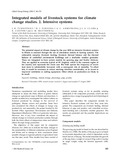JavaScript is disabled for your browser. Some features of this site may not work without it.
| dc.contributor.author | Turnpenny, J. R. | - |
| dc.contributor.author | Parsons, David J. | - |
| dc.contributor.author | Armstrong, A. C. | - |
| dc.contributor.author | Clark, J. A. | - |
| dc.contributor.author | Cooper, K. C. | - |
| dc.contributor.author | Matthews, A. M. | - |
| dc.date.accessioned | 2011-09-29T16:59:58Z | |
| dc.date.available | 2011-09-29T16:59:58Z | |
| dc.date.issued | 2001-01-01T00:00:00Z | - |
| dc.identifier.issn | 1354-1013 | - |
| dc.identifier.uri | http://dx.doi.org/10.1046/j.1365-2486.2001.00401.x | - |
| dc.identifier.uri | http://dspace.lib.cranfield.ac.uk/handle/1826/1734 | |
| dc.description.abstract | The potential impact of climate change by the year 2050 on intensive livestock systems in Britain is assessed through the use of simulation models of farming systems. The submodels comprise livestock feeding, livestock thermal balance and the thermal balance of controlled environment buildings and a stochastic weather generator. These are integrated to form system models for growing pigs and broiler chickens. They are applied to scenarios typical of SE England, which is the warmest region of the country and represents the worst case. For both species the frequency of severe heat stress is substantially increased, with a consequent risk of mortality. To offset this, it would be necessary to reduce stocking densities considerably, or to invest in improved ventilation or cooling equipment. Other effects on production are likely to be small. | en_UK |
| dc.publisher | Blackwell Publishing Ltd | en_UK |
| dc.title | Integrated models of livestock systems for climate change studies. 2. Intensive systems. | en_UK |
| dc.type | Article | - |
Files in this item
This item appears in the following Collection(s)
-
Staff publications (SAS) [907]
